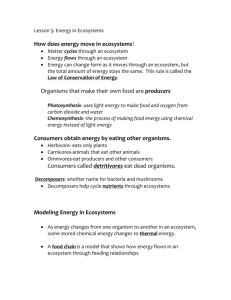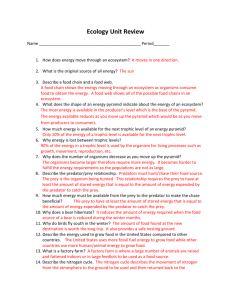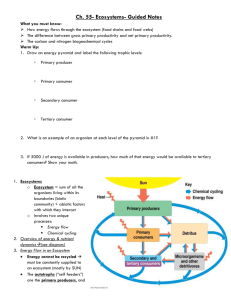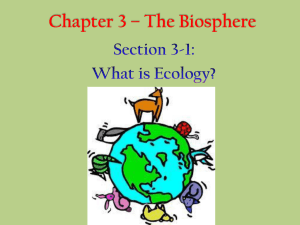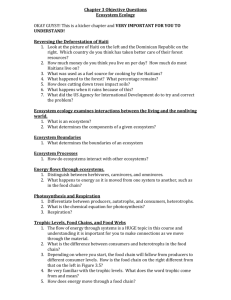Ecology - Phsgirard.org
advertisement
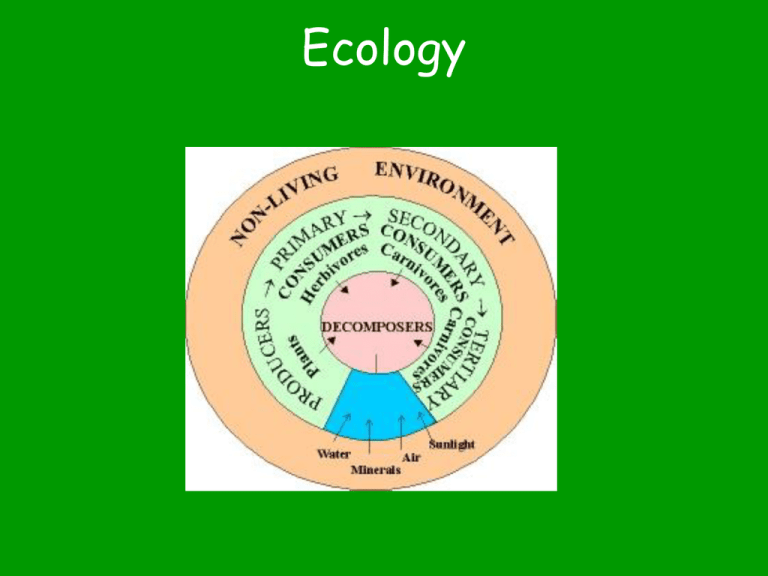
Ecology
Ecology
• The study of interactions between
organisms & their environment
Biotic factors
• Living, or once
living, organisms
in an environment
Abiotic factors
•
•
•
•
•
•
Non-living parts of an environment
Air
Water
Temperature
Light
Soil
Salinity
Ecological levels of organization
(Smallest to Largest)
Organism – a single member of a species
Population – a group of interbreeding
organisms of the same species which live
in the same habitat
Competition for food, water, mates,
shelter, etc… due to lack of resources
Ecological levels of organization
(Smallest to Largest)
Biological community – Interacting
populations in the same habitat
• Population changes can affect each
other in a community
Ecological levels of organization
(Smallest to Largest)
Ecosystem – Plant & animal populations
interact with each other & the abiotic
factors in an environment
1.
Terrestrial ecosystems
2.
Aquatic ecosystems
Ecological levels of organization
(Smallest to Largest)
Biosphere –
All ecosystems
interacting on
Earth
Organisms in ecosystems
• Habitat – place an organism lives out its
life
• Niche – the job or role of an organism
in its environment
1.
How does it meet needs for food?
2.
Shelter
3.
How and where it survives
4.
Reproduction
Symbiosis (living together)
A close and permanent relationship
between organisms of different species
3 Types
Mutualism
Commensalism
Parasitism
Mutualism
• A symbiotic relationship where both
species benefit e.g.
1.
2.
3.
4.
Clown fish and sea anemone
Humans and pets
Ants & Peony flowers
Lichens – algae and a fungus
British Soldier Lichen
Commensalism
• A symbiotic relationship in which one
species benefits and the other is
neither helped nor harmed
e.g. Epiphytes and trees (Epiphytes grow in the tree
{habitat}, but the tree does not benefit nor is it
harmed)
Egret sitting on a rhino
Barnacle on a whale
Parasitism
A symbiotic relationship where one
organism benefits and the other is
harmed e.g.
1.
2.
Dog and tick
Brown headed cowbird and other passerines
What type of symbiosis?
Energy flow in an ecosystem
Energy flow in an ecosystem
Producers (Autotrophs) – obtain energy
from the sun via photosynthesis
Consumers (Heterotrophs) – obtain
energy by eating producers or other
consumers
Types of consumers
Primary consumer – eats producers
• Herbivores – eat only producers
• Detritivores- eat detritus (or humus) dead
decaying organic material
Secondary consumer – eats primary or other
secondary consumers
• a. Carnivore – eat other consumers
• b. Omnivore eats both consumers and producers
• c. Scavenger – eat animals that have already died
• d. Decomposers – break down dead organisms
Energy flow in an ecosystem
• Food chain – model used by scientists
to show the flow of energy in an
ecosystem
• Food web – model used by scientists
to show all the possible feeding
relationships at each trophic level in a
community
Energy flow in an ecosystem
Pyramid of Energy – 90% of energy lost in each
trophic level
Producers get 100% of energy available
Primary consumers get 10% of energy available
Secondary consumers get 1% of energy available
Tertiary consumers get 0.1% of energy available
Energy flow in an ecosystem
Pyramid of Numbers – Population size should
decrease at each higher trophic level
• 3000 Grasses support
• 250 grasshoppers which support
• 25 birds which support
• 1 fox
The pyramid below is a way of
showing how the numbers of
organisms decrease along the food
chain, finishing with the
top carnivore at the apex.
A = plankton,
B = shrimp,
C = fish,
D = seagull
Energy flow in an ecosystem
• Pyramid of Biomass – total mass of
living matter at each trophic level
• 100 kg of grain is needed to support
• 10 kg of beef which supports
• 1 kg of human tissue
Cycles in Nature
•
•
•
•
Water
Carbon
Nitrogen
Phosphorus
Water cycle
Evaporation
Transpiration
Condensation
Precipitation
Runoff
Infiltration
Carbon Cycle
Atmospheric CO2 (burning, fuel combustion,
respiration)
Death & decay result in fossil fuel formation
Photosynthesis (CO2 conversion into glucose)
Biomass – storage of carbon as coarse
woody debris
Carbon Cycle
Nitrogen Cycle
Atmospheric Nitrogen fixation by plants, bacteria, & lightning
Urine (From protein catabolism)
Fecal matter & fertilizers
Dead & Decaying plant or animal matter
Nitrogen evaporates into atmosphere from ground (Due to
denitrifying bacteria)
Nitrogen Cycle
Phosphorus Cycle
Plants obtain phosphorus from soil
Animals obtain phosphorus by eating plants
Animals die and decomposers break down
phosphorus compounds and phosphorus
returns to the soil (phosphates)
Phosphorus Cycle

